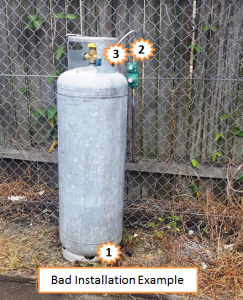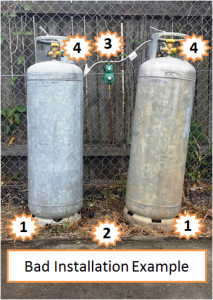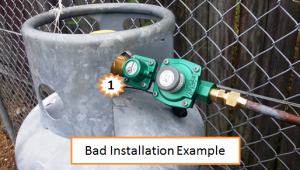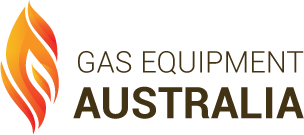A Step-by-Step Guide to set up correct a LP Gas installation
When setting up a LP Gas installation with cylinders and regulators there are a lot of things that can go wrong.
A certified plumber or gas fitter is usually aware of dangers and would avoid the following bad installations.
The LP Gas installations below are bad examples and should not be copied. These pictures should be an example of how NOT to install, set up or use them.
Always make sure you get a certified plumber or gas fitter involved.

In this example the LP Gas installation has the following issues:
- The cylinder should not stand on soil.
- It is not permitted to fix the regulator to a fence.
- The regulator always should be fixed on the same level or higher than the cylinder valve.
How to make it better?
For example you might want to think about:
- Installing the cylinders onto concrete pads. Make sure the cylinders are on the same level and stand straight.
- Mount the regulator securely. This can be for example the wall of a house or in a cylinder compartment for installations on boats or caravans.
- To avoid contamination from plasticizer (when flexible pigtails are being used) mount the regulator on a higher level or the same level as the valve of the cylinder.
- You may be able to position the installation under a roof or building (if gas rules permit) to protect the regulator from water and dirt ingress.

In this example the LP Gas installation has the following issues:
- The cylinder should not stand on soil.
- It is not permitted to fix the regulator to a fence.
- The regulator should always be fixed on the same level or higher than the cylinder valve.
- Only one bottle is connected.
How to make it better?
For example you might want to think about:
- Installing the cylinders onto concrete pads. Make sure the cylinders are on the same level and stand straight.
- Mount the regulator securely. This can be for example the wall of a house or in a cylinder compartment for installations on boats or caravans.
- To avoid contamination from plasticizer (when flexible pigtails are being used) mount the regulator on a higher level or the same level as the valve of the cylinder.
- If only using a single cylinder don’t leave one pigtail unconnected as it can leak and cause danger or be contaminated by water, dirt or insects. Only experienced and certified gas plumbers should modify installations.

In this example the LP Gas installation has the following issues:
- The cylinders should not stand on soil.
- The bottles should be on the same level
- It is not permitted to fix the regulator to a fence.
- The regulator always should always be fixed on the same level or higher than the cylinder valve.
How to make it better?
For example you might want to think about:
- Installing the cylinders onto concrete pads.
- These two bottles in our example dont sit straight and securely. Make sure the cylinders are on the same level and stand straight.
- Mount the regulator securely. This can be for example the wall of a house or in a cylinder compartment for installations on boats or caravans.
- To avoid contamination from plasticizer (when flexible pigtails are being used) mount the regulator on a higher level or the same level as the valve of the cylinder.

In this example the LP Gas installation has the following issues:
- A dual (or twin) stage regulator is not permitted to be connected directly to the cylinder.
How to make it better?
For example you might want to think about:
- The regulator should be mounted on a suitable wall or post and be connected with a pigtail.
- There are some regulators that are allowed to be screwed directly into the LP Gas bottle (BBQ regulators for example). The one in the picture is not one of them. Talk to your gas plumber or gas fitter to find out what kind of regulator you have and how it has to be installed.

In this example the LP Gas installation has the following issues:
- The regulator always should be fixed on the same level or higher than the cylinder valve.
- The gas installation has to be away from any openings and comply with the appropriate rules and regulations.
- The gas cylinder should not stand on an unstable structure and never on milk crates.
How to make it better?
For example you might want to think about:
- To avoid contamination from plasticizer (when flexible pigtails are being used) mount the regulator on a higher level or the same level as the valve of the cylinder.
- The gas installation is too close to a window. In general exchange cylinders have to be 1000m away from a door, 150mm away if it is standing underneath an openable window and 1000mm away from a pit or drain or an air vent or opening.
- Installing the cylinders onto concrete pads or suitable solid (non plastic) structure.
- Make sure the cylinders are on the same level and stand straight. Otherwise there is a danger that the cylinder can fall over and cause harm.






